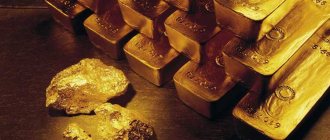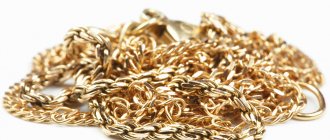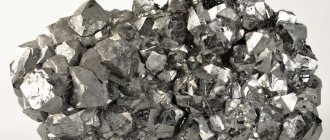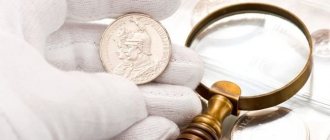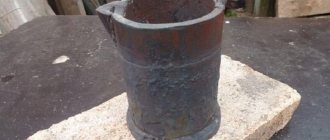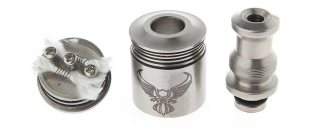Gold is a metal familiar to everyone. Jewelry made from precious metal is popular, especially among women. Gold is one of the most expensive metals in the world and is one of the top three in terms of cost per gram. You can see different numbers on the products. They mean the sample of the metal. Having certain knowledge, you can determine the density of gold.
STRUCTURE
Crystal structure of gold
Crystallizes in the cubic system, in the form of octahedra, rhombic dodecahedrons, cubes and more complex crystals; They are often distorted, strongly elongated, forming “wires”, “hairs”, or flattened parallel to the octahedron face. Native gold, especially low-grade gold, is characterized by a variety of growth forms; it is usually in the form of skeletal crystals, dendrites, thread-like and twisted-filamentary crystals. Streak-like and irregular lump-like, “hooked” discharges are widespread; Their surfaces often contain imprints of crystals of other minerals, the aggregates of which included accumulations of native gold. Etching reveals the crystalline granular structure of the gold particles.
PROPERTIES
Gold bars and nuggets
Gold is a very heavy metal: the density of pure gold is 19.32 g/cm³ (a ball of pure gold with a diameter of 46.237 mm has a mass of 1 kg). Diamagnetic, that is, the magnetic field in gold weakens. Among metals, it ranks seventh in density after osmium, iridium, rhenium, platinum, neptunium and plutonium. Tungsten has a density comparable to gold (19.25). The high density of gold makes it easier to extract, which is why even simple technological processes - for example, washing at sluices - can provide a high degree of gold recovery from the washed rock. Gold is a very soft metal: hardness on the Mohs scale is ~2.5, on the Brinell scale 220-250 MPa (comparable to the hardness of a fingernail). Gold is also highly ductile: it can be forged into sheets up to ~0.1 µm (100 nm) thick (gold leaf); With such a thickness, gold is translucent and in reflected light has a yellow color, in transmitted light it is colored bluish-greenish, complementary to yellow. Gold can be drawn into wire with a linear density of up to 2 mg/m. The melting point of gold is 1064.18 °C (1337.33 K), boils at 2856 °C (3129 K). The density of liquid gold is less than solid gold and is 17 g/cm3 at the melting point. Liquid gold is quite volatile and actively evaporates long before its boiling point.
Helpful information
The fact is that if you wash the yellow metal with a stream of water, you can get rid of minerals that have a lower density (and almost all minerals found in the earth’s crust have a lower density). After intensive washing, they are washed off, after which the metal itself is concentrated in the heavy fraction, which is sand consisting of minerals of high density, this is called concentrate. After which the concentrate should be washed to look for any jewelry that has settled in it.
If we talk about modern times, the mining method, which is based on the high density of the metal, has found wide application for extreme tourism. Such tourism in most cases is organized by the owners of private mines, which have already been developed and are economically unprofitable. For a fee, tourists can be taught simple mining techniques. Of course, you should not expect that you can get a troy ounce in this way, but delight is undoubtedly guaranteed. Who doesn't want to feel like a real gold miner! For such reasons, tourism of this type is one of the most popular.
If we talk about comparing the densities of gold and silver, the latter metal has a density of 10,500 kg/cubic meter. m. But the density of tungsten is very high, it is almost comparable to the density of one of the most expensive metals and is no more than 1% inferior to it. These are the reasons why the value of gold and silver is very high all over the world. Of course, silver is significantly inferior in this regard. The composition here also varies - the fact is that pure silver is used very rarely. This is explained by the fact that in its pure form it has increased softness, which creates certain difficulties. If we are talking about 925 silver, this means that its composition should include no more than 7.5% of various types of impurities. 925 silver contains platinum, and may also contain zinc, germanium and often silicon. In this way, you can make silver not only less soft, but also affect the change in its color. And the physical properties also change for the better, for example, it is less susceptible to oxidation.
This kind of silver is one of the most common in the jewelry industry because it has an attractive appearance and unique physical properties. It was used in England for minting coins, which is a very important indicator.
If we compare with 960 standard, then, undoubtedly, products made from such metal are very sophisticated, but they are not particularly durable. Therefore, it is not possible to use it for everyday wear. Such jewelry can only be worn on special occasions, and the beauty of products of this type can cause true delight among all connoisseurs of beauty.
RESERVES AND PRODUCTION
Golden Nugget
The gold content in the earth's crust is very low - 4.3·10-10% by weight (0.5-5 mg/t), but deposits and areas sharply enriched in the metal are very numerous. Gold is also found in water. One liter of both sea and river water contains less than 5·10−9 grams of Au, which approximately corresponds to 5 kilograms of gold in 1 cubic kilometer of water. Gold deposits occur predominantly in areas of granitoid development; a small number of them are associated with basic and ultrabasic rocks. To obtain gold, its basic physical and chemical properties are used: its presence in nature in a native state, the ability to react with only a few substances (mercury, cyanide). With the development of modern technologies, chemical methods are becoming more popular. In 1947, American physicists Ingram, Hess and Haydn conducted an experiment to measure the effective cross section for the absorption of neutrons by mercury nuclei. As a side effect of the experiment, about 35 micrograms of gold was obtained. Thus, the centuries-old dream of alchemists was realized - the transmutation of mercury into gold. However, such gold production has no economic significance, since it costs many times more than extracting gold from the poorest ores.
How to independently determine the specific gravity of gold + table of sample weights
Good afternoon.
Today I will continue talking about precious metals. We admire their shine in openwork items, price them in jewelry stores, weigh them in our hands, feeling the pleasant heaviness of the precious metal. Today my friend brought a ring and asks me to determine the material of the product. You can't tell by color whether it's gold or platinum. The sample is half erased and cannot be seen. From my school physics course, I vaguely remember that the specific gravity of gold is very high. Does this make any difference? I'll try to figure it out.
ORIGIN
Gold products
Native gold is the main form of gold found in nature. It concentrates in hydrothermal deposits forming gold ores, unevenly distributed in fractured vein quartz and in sulfides - pyrite, arsenopyrite, pyrrhotite, etc. In essentially sulfide ores, native gold is finely dispersed. During the oxidation of ores on the earth's surface, fine native gold is partially dissolved and redeposited; in some cases it enriches the upper parts of ore bodies. The processes of their destruction lead to the release of particles of native gold and their accumulation in placers; moving with water flows together with other plastic material, the particles become rounded, rounded, deformed, and partially recrystallized; As a result of electrochemical corrosion, a thin shell of high-fine gold is formed on them, which leads to a general increase in the standard of native gold in placers.
Determination of carat weight
British carats are a traditional value used to measure the purity of gold and its weight in a product. The smallest value is 8 carats (K). The specific gravity of 999 gold is 24 carats. If other elements are added to the alloy to change the characteristics of the metal, the carat value drops. The 18-karat precious metal contains 6 parts of impurities and 18 parts of pure gold.
For example, high-grade 917 gold has a mass of 22 carats. And such a popular 585 alloy is only 14 carats.
APPLICATION
Golden coins
In terms of its chemical resistance and mechanical strength, gold is inferior to most platinum group metals, but is irreplaceable as a material for electrical contacts. Therefore, in microelectronics, gold conductors and gold electroplating of contact surfaces, connectors, and printed circuit boards are used very widely. Gold is used as a target in nuclear research, as a coating for mirrors operating in the far infrared range, and as a special shell in a neutron bomb. A thin layer of gold (20 nm) on the inner surface of window and stained glass glass significantly reduces unwanted heat losses in winter, and in summer it protects the interior of buildings and vehicles from heating by infrared rays. Gold solders wet various metal surfaces very well and are used in metal soldering. Thin gaskets made from soft gold alloys are used in ultra-high vacuum technology. The traditional and largest consumer of gold is the jewelry industry. Jewelry is made not from pure gold, but from its alloys with other metals, which are significantly superior to gold in mechanical strength and durability. Currently, Au-Ag-Cu alloys are used for this, which may contain additives of zinc, nickel, cobalt, and palladium. The corrosion resistance of such alloys is determined mainly by their gold content, and the color shades and mechanical properties are determined by the ratio of silver and copper. Dentistry consumes significant amounts of gold: crowns and dentures are made from alloys of gold with silver, copper, nickel, platinum, and zinc. Such alloys combine corrosion resistance with high mechanical properties. Gold compounds are included in some medications used to treat a number of diseases (tuberculosis, rheumatoid arthritis, etc.). The radioactive isotope 198Au (half-life 2.967 days) is used in the treatment of malignant tumors in radiotherapy.
Gold – Au
| Molecular weight | 196.97 g/mol |
| origin of name | Proto-Slavic “*zolto” (“gold”) is related to Lit. geltonas "yellow", Latvian. zelts "gold". |
| IMA status | valid, first described before 1959 (before IMA) |
How to distinguish real yellow metal from a fake
At the moment, there is a very large percentage of counterfeit gold on both the Russian and foreign markets. There is a huge risk of purchasing gold jewelry containing up to 5% of the precious metal or without it at all. Basic rules when buying gold will help you avoid feeling deceived.
First, you should take a good look at the product. There must be a sample on it. Moreover, it should not consist of crooked numbers or blurry marks. Otherwise, this is the first sign of a counterfeit.
A sample of a unified state hallmark for gold products.
The next sign of a fake is the reverse side of the precious metal jewelry. It must be as well made as the front side, otherwise it is a low-quality product. It is also possible to determine the quality of a product using a characteristic such as gold density, but it is impossible to conduct such an experiment in a store.
There is also a way to determine it, called a strength test. True, it is not always possible to scratch a gold item in front of the seller, so this method cannot be implemented.
Iodine test.
The following chemical methods can serve as good ways to determine the quality of a product. You can drop a little iodine on the yellow metal jewelry. If the speck is dark in color, then we can speak with confidence about the quality of the product being offered. Table vinegar can also help. If, after three minutes spent in it, the precious metal has darkened, then you can safely take the product to a landfill.
Gold chloride can be a great help in determining quality. From the chemistry course, it became known not only the density of gold, but also the fact that it cannot enter into any chemical reactions. Therefore, if after applying gold chloride to a precious metal it begins to deteriorate, then this is a real fake and should belong in the trash.
One of the best ways to protect yourself from purchasing counterfeit goods is to purchase precious metal products in well-known specialized stores.
In this case, there is a high probability of purchasing a truly high-quality product. Even though their price is a little higher than in various shops and markets, the quality is worth it. Otherwise, you can purchase a counterfeit product and very much regret the money saved.
PHYSICAL PROPERTIES
| Mineral color | rich yellow, fading to white-yellow with a predominance of silver |
| Stroke color | brilliant yellow |
| Transparency | opaque |
| Shine | metal |
| Cleavage | No |
| Hardness (Mohs scale) | 2,5-3 |
| Strength | malleable |
| Kink | jagged |
| Density (measured) | 15 – 19.3 g/cm3 |
| Radioactivity (GRapi) | 0 |
| Magnetism | diamagnetic |
Gold Assay Density
| gold, silver, copper | 11,54 | 11540 | ||
| pink | gold, silver, palladium, copper | 11,56 | 11560 | |
| 585 | white | gold, silver, nickel, zinc, copper | 12,85 | 12850 |
| gold, silver, palladium | 14,74 | 14740 | ||
| green | gold, silver, copper | 13,92 | 13920 | |
| yellow | gold, silver, copper | 13,70 | 13700 | |
| red | gold, silver, copper | 13,24 | 13240 | |
| 750 | white | gold, silver, nickel, zinc | 15,38 | 15380 |
| gold, silver, palladium | 16,44 | 16440 | ||
| green | gold Silver | 15,96 | 15960 | |
| yellow | gold, silver, copper | 15,45 | 15450 |
